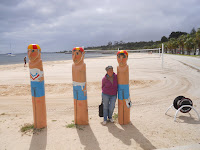You have been asking where are the blogs?
Firstly I would like to thank those who gave me feedback on their enjoyment of the blog. You really encouraged me to keep going and now we have a wonderful record of our fabulous adventure.
Since we arrived in Melbourne, we have virtually been staying with people and enjoyed their generous hospitality and delicious food. We were having such a good time that the blogs have gone by the wayside but I can assure you it will be done to complete the record of this amazing trip so it can remain in cyberspace forever.
So here is a brief update with a more detailed version to follow later.
 We spent six days in Melbourne for Christmas with Penny and Chris in their delightful flat, then on to Jillian (Brian’s sister) and Neil in Albury where we spent three days. We were there for New
We spent six days in Melbourne for Christmas with Penny and Chris in their delightful flat, then on to Jillian (Brian’s sister) and Neil in Albury where we spent three days. We were there for New  Year’s Eve and were joined their friends. We certainly enjoyed their company, the lovely air-conditioned house and some very yummy food. Neil has a new Porsche so I felt very important going for a ride – what a beautiful car.
Year’s Eve and were joined their friends. We certainly enjoyed their company, the lovely air-conditioned house and some very yummy food. Neil has a new Porsche so I felt very important going for a ride – what a beautiful car. After an overnight stay at Yass we went to Gwandalan which is just south of

Newcastle and is on foreshore of Lake Macquarie, to see Jenny (my sister) and Doug and had a wonderful eight days of chatting, relaxing, boating, sailing, eating amazing food and have a great time, not to mention the disastrous games of Scrabble (I lost all three games!)

We then went to Wellington (which is near Dubbo) to see Auntie Gwen. It was great to see her again and I was able to do some chores and gardening.
Then DISASTER hit!! On Wed 13th Jan I received a phone call from a friend to say
 that my investment property in Ipswich (which was a dud anyway) was underwater!!! What a shock!!! We had to wait for the water recede and also all roads home were blocked. We left on Friday after we shared a morning breakfast on bacon and eggs with Gwen at our caravan park by the river. We stayed the night at Coonabarabran and I caught up with old family friends Gwen and Athol. Then a long drive to Tenterfield the next day. On Sunday we left at 5am and headed straight to Ipswich to spend the day helping with the clean up. A rather unwanted welcome home!!
that my investment property in Ipswich (which was a dud anyway) was underwater!!! What a shock!!! We had to wait for the water recede and also all roads home were blocked. We left on Friday after we shared a morning breakfast on bacon and eggs with Gwen at our caravan park by the river. We stayed the night at Coonabarabran and I caught up with old family friends Gwen and Athol. Then a long drive to Tenterfield the next day. On Sunday we left at 5am and headed straight to Ipswich to spend the day helping with the clean up. A rather unwanted welcome home!! What a massive job. On the Sat all the carpets had to be pulled up and everything
 had to been thrown out. All the plasterboard had to come off and the place had to be guttered. Owners unable to attend were able to pay to have the unit cleared which I did.
had to been thrown out. All the plasterboard had to come off and the place had to be guttered. Owners unable to attend were able to pay to have the unit cleared which I did. There were an army of volunteers. As there was already a team working in my unit, we went and helped other unit. All plasterboard from the walls and ceilings was on the floor and had to be removed by wheelbarrow and the kitchen had to be dismantled. Brian worked like a Trojan and I did my bit. After a couple of hours we had a volunteer couple join us which made a huge difference. He was a landscaper so knew how to use a shovel and wheel barrow. The only thing left to do was to hose the place out with a gurney and put a microbe killer on the frame.
We had to go so, very weary and footsore, we headed for home. The drive home through the back way to Boonah was magnificent. It was so very green and I really think it was the prettiest drive of the whole trip. How lucky we are to live in this beautiful part of Australia.

When we arrived at the gate the grass was over waist high and the bitumen road was
as narrow as path. The trees in the front paddock have grown so much. Then we came
 down into the creek and oh dear – the caravan got bogged!!
down into the creek and oh dear – the caravan got bogged!! It took nearly three hours to get it out by winching and pulling. The ropes broke twice and the van was very close to a large post which threatened to scratch and dint the side of the caravan. Finally we managed to winch it sideways and then pull it out unharmed.
Totally exhausted, sweaty and very weary we were able to finally have a shower (thank goodness for solar hot water),and relax with a stiff scotch and go to bed.






















































